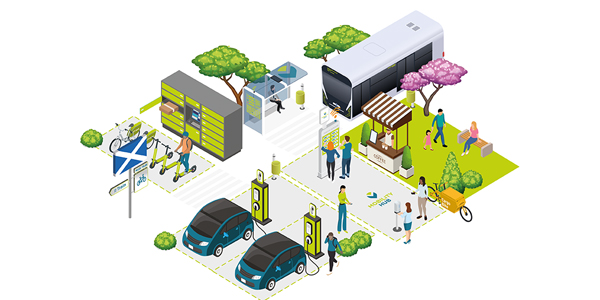
CoMoUK
By Bart Treece, Director, Mobility Innovation Center
It’s exciting to see the shift towards cleaner transportation with the rise of electric buses, cars, and even bikes and scooters. With this change comes an opportunity to rethink how we tie these types of travel together in places that were designed primarily for vehicles.
Let’s start with what we have now, park and rides, which is a straightforward concept: drive, park, take the bus or train. The intent of the design and use is predominately to support motor vehicle traffic and storage to help connect people with transit routes. But that’s changing, with a jolt towards an electric future.
A mobility hub brings together all types of transportation modes in a welcoming, user-centered place. Meaning, however you want to travel — be it walking, rolling, rideshare, bus or train — you have more choices to continue your trip and information to guide you along the way. The Mobility Innovation Center recently launched a new project, led by Drs. Jan Whittington, Hyun Woo “Chris” Lee, and Rachel Berny of the UW College of Built Environments, to look at how a transit agency would electrify these shared spaces.
Partnerships for an electric and inclusive future
The sponsor of this research, King County Metro, sees a future with their park and rides and transit centers becoming mobility hubs, with the goal of electrifying their fleet by 2035. They recognize that they can’t do this alone. Sound Transit, Seattle City Light, and Challenge Seattle are also contributing to the research as this will help address some of their challenges related to use of space and charging capabilities.
There are a lot of questions that need to be addressed, which is why research will be helpful, including:
- What are the essential components and design considerations a public agency needs to consider for converting existing facilities into a mobility hub with electrification infrastructure?
- What are guidelines to prioritize conversions and electrification infrastructure to achieve equitable outcomes?
- How would electrification affect greenhouse gas (GHG) emissions and estimated electrical loads?
Electrified mobility hubs can be a game changer. They could help remove barriers to electric vehicle (EV) adoption by providing new community resources and transportation connections. Utility providers become, in part, the new gas station, and the transit agency shifts from operating buses to being a bridge to a more sustainable, inclusive future.